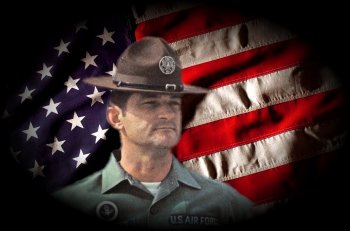Evolution
of the MTI
and Air Force Basic Training
|
 |
|
| They are professionals . . . members of a demanding profession. They are the Air Force's Military Training Instructors. They take the young men and women of America and impart to them the basic military skills which are so vital in the making of future airmen. By personal example they instill in their trainees a sense of pride, integrity and the will to succeed. In a few short weeks they do this and when they see their trainees leave, the Training Instructors turn to receive a new group, a new flight of future airmen and they start again.
|
By whatever name you call them, Military Training Instructors, Drill Instructors or Drill Sergeants, these dedicated professionals have a long and honored history as old as the concept of drill itself.
Drilling is one of the most critical aspects of military life. Since the earliest of times, it has been the backbone of teamwork, obedience to commands and the discipline that is so vital to the military.
|
| It can be argued that drill dates as far back as 500 B.C. and the first drill instructor was Sun Tzu the author of "The Art of War." Sun Tzu was hired by King Helu of Wu to train a contingent of one hundred-eighty palace women. Sun Tzu organized them into two units, with the king's two favorite concubines as leaders. He equipped each person with the weapon of the times, the dagger-axe, and taught them close order drill. When the women did not follow the instructions to his liking, he punished them by beheading the unit leaders. |
 |
|
|
| It is more widely accepted that Drills date from Roman times when troops were first grouped into compact tactical formations known as phalanxes. Throughout the middle ages, more armies began to count on some form of marching and drilling. By the eighteenth-century, virtually every army in the civilized world had adapted the techniques put forth by the Roman Empire. |
 |
|
|
| Baron Friedrich von Steuben - The First U.S. Drill Instructor |
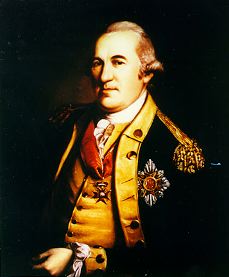 In 1775, when this country was striving for independence and existence, the nation's leaders were confronted with the problem of not only establishing a government but also of organizing an army that was already engaged in war. From the "shot heard around the world," on 19 April 1775, until Valley Forge in 1778, revolutionary forces were little more than a group of civilians fighting Indian-style against well-trained, highly disciplined British Redcoats. For three years, General George Washington's troops had endured many hardships--lack of funds, rations, clothing, and equipment. In addition, they had suffered loss after loss to the superior British forces. These hardships and losses mostly stemmed from the lack of a military atmosphere in country. Thus, an army was created with little or no organization, control, discipline, or teamwork. In 1775, when this country was striving for independence and existence, the nation's leaders were confronted with the problem of not only establishing a government but also of organizing an army that was already engaged in war. From the "shot heard around the world," on 19 April 1775, until Valley Forge in 1778, revolutionary forces were little more than a group of civilians fighting Indian-style against well-trained, highly disciplined British Redcoats. For three years, General George Washington's troops had endured many hardships--lack of funds, rations, clothing, and equipment. In addition, they had suffered loss after loss to the superior British forces. These hardships and losses mostly stemmed from the lack of a military atmosphere in country. Thus, an army was created with little or no organization, control, discipline, or teamwork.
Recognizing the crisis, General Washington, through Benjamin Franklin, the American
Ambassador to France, enlisted the aid of a Prussian officer, Baron Friedrich von Steuben. Upon his arrival at Valley Forge on 23 February 1778, von Steuben, a former staff officer with Frederick the Great, met an army of several thousand half-starved, wretched men in rags. He commented that a European army could not be kept together in such a state. To correct the conditions that prevailed, he set to work immediately and wrote drill movements and regulations at night and taught them the following day to a model company of 120 men selected from the line.
Discipline became a part of military life for these selected individuals as they learned to respond to command without hesitation. This new discipline instilled in the individual a sense of alertness, urgency, and attention to detail. Confidence in himself and his weapon grew as each man perfected the fifteen l-second movements required to load and fire his musket. As the Americans mastered the art of drill, they began to work as a team and to develop a sense of pride in themselves and in their unit.
Watching this model company drill, observers were amazed to see how quickly and orderly the troops could be massed and maneuvered into different battle formations. Officers observed that organization, chain of command, and control were improved as each man had a specific place and task within the formation. Later, the members of the model company were distributed throughout the Army to teach drill. Through drill, they improved the overall effectiveness and efficiency of the Army.
To ensure continuity and uniformity, von Steuben, by then a major general and the Army Inspector General, wrote the first Army field manual in 1779, The Regulations for the Order and Discipline of the Troops of the United States, commonly referred to as the Blue Book. The drill procedures initiated at Valley Forge were not changed for 85 years, until the American Civil War, and many of the drill terms and procedures are in effect today.
Drill commands are about the same as at the time of the War of 1812, except that then the officers and noncommissioned officers began them by saying, "Take care to face to the right, right, face." Also, during the American revolutionary period, troops marched at a cadence of 76 steps a minute instead of the current cadence of 120 steps. Then units performed precise movement on the battlefield, and the army that could perform them best was often able to get behind the enemy, or on his flank, and thus beat him. Speed spoiled the winning exactness. Also, firearms did not shoot far or accurately in 1776, so troop formations could take more time to approach the enemy.
|
|
| As our Nation went into the twentieth-century, new technology changed that style of fighting forever. Automatic weapons increased the fire power preventing soldiers from standing shoulder to shoulder, forcing them to disperse over the battlefield. Although there is no longer a tactical necessity for marching and drilling, one constant remains, the need for military discipline within the rank and file. And just as in the beginning, when the first soldiers learned to follow commands, someone had to teach it. The rank and titles changed through time, but wherever you found drill and military indoctrination, there stood the drill instructor instilling in their trainees a sense of pride, integrity and the will to succeed. |
 |
|
|
| The Army Air Forces Basic Military School for the production of new officers and enlisted men was established on 01 February 1946 at San Antonio, Texas. It was known as indoctrination training and the instructors were called flight marchers. In September 1947, the Air Force became a separate service and Flight Marchers were teaching drill at three different bases, Sampson AFB, New York, Parks AFB, California, and Lackland AFB, Texas. |
|
| US Marine Corps Established First Drill Instructor School |
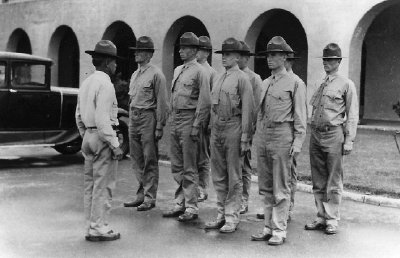 Prior to the conception of the recruit depots and Drill Instructor Schools, noncommissioned officers at the various posts and stations trained newly joined Marine recruits in the "principles of military movements" and the use of the rifle. The quality of training was as varied as the number of bases and noncommissioned officers. In 1911, MajGen. William Biddle, 11th Commandant of the Marine Corps, determined that such training was inadequate and established the first centralized recruit depots at Norfolk, Va.; Philadelphia; Mare Island, Calif. and Puget Sound, Wash. By 1915, East Coast recruit training was centralized at MCRD Parris Island, S.C. In 1923, MCRD San Diego assumed the duties as the sole recruit depot for the West Coast. Prior to the conception of the recruit depots and Drill Instructor Schools, noncommissioned officers at the various posts and stations trained newly joined Marine recruits in the "principles of military movements" and the use of the rifle. The quality of training was as varied as the number of bases and noncommissioned officers. In 1911, MajGen. William Biddle, 11th Commandant of the Marine Corps, determined that such training was inadequate and established the first centralized recruit depots at Norfolk, Va.; Philadelphia; Mare Island, Calif. and Puget Sound, Wash. By 1915, East Coast recruit training was centralized at MCRD Parris Island, S.C. In 1923, MCRD San Diego assumed the duties as the sole recruit depot for the West Coast.
During World War II, the Drill Instructor Schools were first established at both depots, but shortages of drill instructors needed to train the influx of new recruits forced the schedule to cover only a couple of weeks. In 1947, academic instructors were added to supplement the staff at the schools and the training syllabus was expanded to ten weeks.
During the Korean War, recruit training was once again in high gear and Drill Instructor School was reduced to 3 1/2 weeks. Exceptionally qualified privates first class were admitted to the school until 1954 when enrollment was restricted to noncommissioned officers.
Today, Drill Instructor School strives to be the premier leadership school in the Marine Corps. It encompasses over 500 hours of academics, physical training and practical application over an 11-week course. Not only are students given a thorough review of all military skills, but they are acquainted with an intensive indoctrination in the conduct, regulations, and procedures governing recruit training. The students also undergo a comprehensive leadership package which includes time management, communication skills, and counseling. Squad instructors continuously evaluate and counsel their respective students to ensure maximum performance.
|
|
| 07 July 1943 - The Air Training Command was established as Army Air Forces Training Command, Forth Worth, Texas. |
|
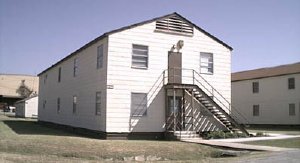 |
04 February 1946 - Basic military training began at what is now Lackland AFB, TX. The Korean and Vietnam Wars severely tested Lackland's capacity to train new recruits and satisfy mobility demands. Training populations in the 1950s soared to 55,000 with only a maximum capacity of 25,000. Rapidly built wooden structures, built in 1941, to include the "Mobilization Open Bay" (MOB) dormitories, burst at the seams and forced the mass erection of a tent city. Temporary facilities, to include the "I" dormitories, were hastily erected as a quick fix to house the new recruits. Base operating support requirements force reactive planning, which often resulted in inadequate implementation. |
|
|
| October 1948 - Basic training began for the Women in the Air Force (WAF). |
|
| 15 November 1950 - Sampson AFB, NY, became a basic military training center when Lackland AFB became seriously overcrowded as the number of men in basic training increased dramatically. More than 19,000 men were sleeping in tents at Lackland, and Senator Lyndon B. Johnson's investigating subcommittee severely criticized the Air Force for accepting more recruits than it could handle. Overcrowding was remedied by reducing basic training from 13 to 8 weeks, suspending enlistments for 2 weeks, and opening additional basic military training centers. |
 |
|
|
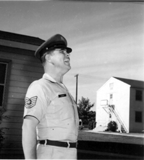 |
| "Tehn-hut," Technical Sgt. Francis " Spunky" Guess calls out to a BMT flight in 1955. This photo was taken at Sampson Air Force Base, N.Y., where Air Force basic training was conducted until the facility was closed in 1956 and all training was moved to Lackland, AFB. (U.S. Air Force photo) |
|
|
|
|
|
| The Air Force closed its east and west coast training centers in 1956 and moved all BMT operations to Lackland. |
|
| 01 July 1953 - BMT input to Parks AFB, CA, was suspended to allow phaseout. |
|
| 01 July 1956 - The basic military training school which opened 15 November 1950 at Sampson AFB, NY, was discontinued. |
|
| 01 January 1957 - Parks AFB, CA, transferred from the command, ending basic military training there. Lackland AFB, TX, was the single site for basic military training. |
|
| February 1966 - Largely because of a meningitis outbreak at Lackland AFB, the Air Force diverted incoming recruits to Amarillo, a base scheduled to close in July 1968. Lackland sent a sizable cadre of permanent party personnel to Amarillo to assist. It was not until the latter part of March that Lackland was back to normal. However, due to the influx of trainees for the Vietnam buildup, Amarillo continued basic military training until November 1968. The last class was graduated on 11 December 1968. |
|
 |
 |
 |
A/2C Brown
3704 BMTS - 1957 |
|
S. SGT. Dodson
3704 BMTS - 1962 |
|
| Up until 1967, the MTIs wore distinctive shoulder boards called "Tiger Stripes." The street MTIs wore blue with two small gold stripes, supervisors wore blue with one wide gold stripe, and the academic instructors wore blue with white stripes. In addition to "Tiger Stripes," MTIs wore the ATC instructor's badge. While wearing the utility uniform, the badge was placed on the hat. |
|
|
| US Marine Corps First to Issue Drill Instructors Smokey Hats |
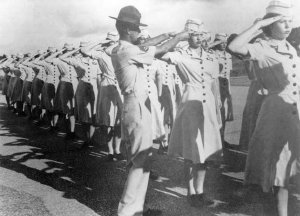 Formally known as the field hat, the campaign cover was commonly worn by Marines of the early 1900's. First issued in the late 1800's, it was made famous by Marines who fought in Nicaragua, Haiti, and China. Its official issue was discontinued prior to World War II, but Marine Corps shooting teams retained it for its functionality. Formally known as the field hat, the campaign cover was commonly worn by Marines of the early 1900's. First issued in the late 1800's, it was made famous by Marines who fought in Nicaragua, Haiti, and China. Its official issue was discontinued prior to World War II, but Marine Corps shooting teams retained it for its functionality.
The 21st Commandant, General Pate, directed that the campaign cover be issued to drill instructors in 1956. Prior to this drill instructors wore the utility cover or garrison cap with the appropriate uniform of the day. Intended to serve as a symbol of their responsibility and authority, the new issue of campaign covers was the idea of MSgt. W. G. Ferrigno, Recruit Training Command, Field Sergeant Major at Parris Island. The initial order of 700 covers was procured from the J. B. Stetson Company. The crew of a Marine transport aircraft picked-up the hats at the factory on Friday, July 20, 1956 and flew them to Parris Island. By 0730 the following morning every drill instructor at the Depot had his new "Smokey."
Only two hat cords are authorized for wear on the Marine Corps campaign hat. A gold cord for flag officers (generals), and scarlet and gold for officers– Both warrant and commissioned.
|
|
|
|
|
|
It wasn't until 31 August 1967 that the MTIs switched over to the ever familiar campaign or smokey bear hat. A veteran of numerous campaigns in the field, steeped in traditions, and in active service in various styles from 1850 through 1939, the campaign hat is a most appropriate symbol for the MTI. The present style of the campaign hat evolved from the straw or felt slough "Hardee Hat" of the 1850s through the center crease designs of the 1880's, to the present day modified "Montana Peak" which was adopted in 1911. The MTIs wore the brown smokey until 1974, when they switch to the present day dark navy blue campaign hat.
|
|
|
|
| 01 July 1971 - Proficiency Pay was implemented in the amount of $50 per month. |
|
| As popular support for the Vietnam War waned and American forces began to pull out of Southeast Asia, ATC’s training requirements gradually diminished. From almost 73,000 personnel assigned in 1972, the command shrank to slightly over 50,000 in 1977. President Richard M. Nixon ended the draft on 30 June 1973, converting the military to an all-volunteer force. Also, during this period the percentage of recruits with a high school education declined to the lowest point in the history of the Air Force. |
 |
|
|
| 29 October 1974 - The Air Training Command motto "Prepare the Man" was discontinued. |
|
| 05 December 1975 - To more fully integrate women into the Air Force, Air Training Command assigned eight female military training instructors to two male Basic Military Training Squadrons. |
|
| In 1975 as part of its ongoing recognition program, the Basic Military Training School created what has come to be known as the Blue Rope awards program. Individuals selected for this coveted honor were permitted to wear the Blue Rope on their MTI campaign hat. The program initially restricted the award to 10% of the instructor force; however, modifications have been made and the exact percentage has varied slightly around the initial goal. Regardless, those selected for this honor earned it through an extremely competitive process and represent the very best that BMTS has to offer. |
 |
|
|
| 23 September 1977 - The Air Force authorized a distinctive hat for female MTIs. The design was taken from the Australian bush hat. Prior to that, the female MTI was distinguished by an aiguillette.
|
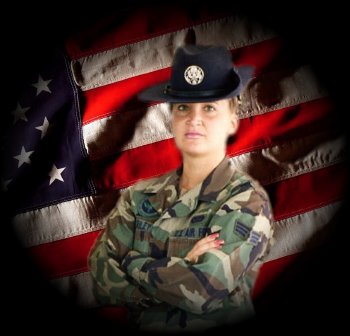 |
|
|
| 20 May 1980 - The Military Training Instructor Monument was dedicated. |
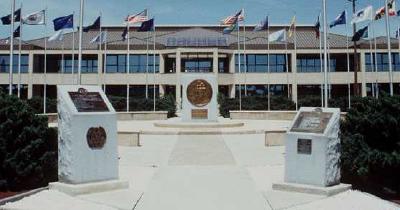 |
|
|
| 01 July 1993 - The Air Training Command was redesignated as the Air Education and Training Command. |
|
| The Air Force has gone through many changes over the last fifty years. But the duty of the MTI has change little. If you walk in and look at how a T-shirt is folded today, it's the same way it was folded in 1947. There may be slight modifications, but overall it's still basically the same mission as they had back in 1947. And that's to train airmen. |
|
The Drill Pad Photo Albums
|
|

|
|

|



 In 1775, when this country was striving for independence and existence, the nation's leaders were confronted with the problem of not only establishing a government but also of organizing an army that was already engaged in war. From the "shot heard around the world," on 19 April 1775, until Valley Forge in 1778, revolutionary forces were little more than a group of civilians fighting Indian-style against well-trained, highly disciplined British Redcoats. For three years, General George Washington's troops had endured many hardships--lack of funds, rations, clothing, and equipment. In addition, they had suffered loss after loss to the superior British forces. These hardships and losses mostly stemmed from the lack of a military atmosphere in country. Thus, an army was created with little or no organization, control, discipline, or teamwork.
In 1775, when this country was striving for independence and existence, the nation's leaders were confronted with the problem of not only establishing a government but also of organizing an army that was already engaged in war. From the "shot heard around the world," on 19 April 1775, until Valley Forge in 1778, revolutionary forces were little more than a group of civilians fighting Indian-style against well-trained, highly disciplined British Redcoats. For three years, General George Washington's troops had endured many hardships--lack of funds, rations, clothing, and equipment. In addition, they had suffered loss after loss to the superior British forces. These hardships and losses mostly stemmed from the lack of a military atmosphere in country. Thus, an army was created with little or no organization, control, discipline, or teamwork. 
 Prior to the conception of the recruit depots and Drill Instructor Schools, noncommissioned officers at the various posts and stations trained newly joined Marine recruits in the "principles of military movements" and the use of the rifle. The quality of training was as varied as the number of bases and noncommissioned officers. In 1911, MajGen. William Biddle, 11th Commandant of the Marine Corps, determined that such training was inadequate and established the first centralized recruit depots at Norfolk, Va.; Philadelphia; Mare Island, Calif. and Puget Sound, Wash. By 1915, East Coast recruit training was centralized at MCRD Parris Island, S.C. In 1923, MCRD San Diego assumed the duties as the sole recruit depot for the West Coast.
Prior to the conception of the recruit depots and Drill Instructor Schools, noncommissioned officers at the various posts and stations trained newly joined Marine recruits in the "principles of military movements" and the use of the rifle. The quality of training was as varied as the number of bases and noncommissioned officers. In 1911, MajGen. William Biddle, 11th Commandant of the Marine Corps, determined that such training was inadequate and established the first centralized recruit depots at Norfolk, Va.; Philadelphia; Mare Island, Calif. and Puget Sound, Wash. By 1915, East Coast recruit training was centralized at MCRD Parris Island, S.C. In 1923, MCRD San Diego assumed the duties as the sole recruit depot for the West Coast.






 Formally known as the field hat, the campaign cover was commonly worn by Marines of the early 1900's. First issued in the late 1800's, it was made famous by Marines who fought in Nicaragua, Haiti, and China. Its official issue was discontinued prior to World War II, but Marine Corps shooting teams retained it for its functionality.
Formally known as the field hat, the campaign cover was commonly worn by Marines of the early 1900's. First issued in the late 1800's, it was made famous by Marines who fought in Nicaragua, Haiti, and China. Its official issue was discontinued prior to World War II, but Marine Corps shooting teams retained it for its functionality.